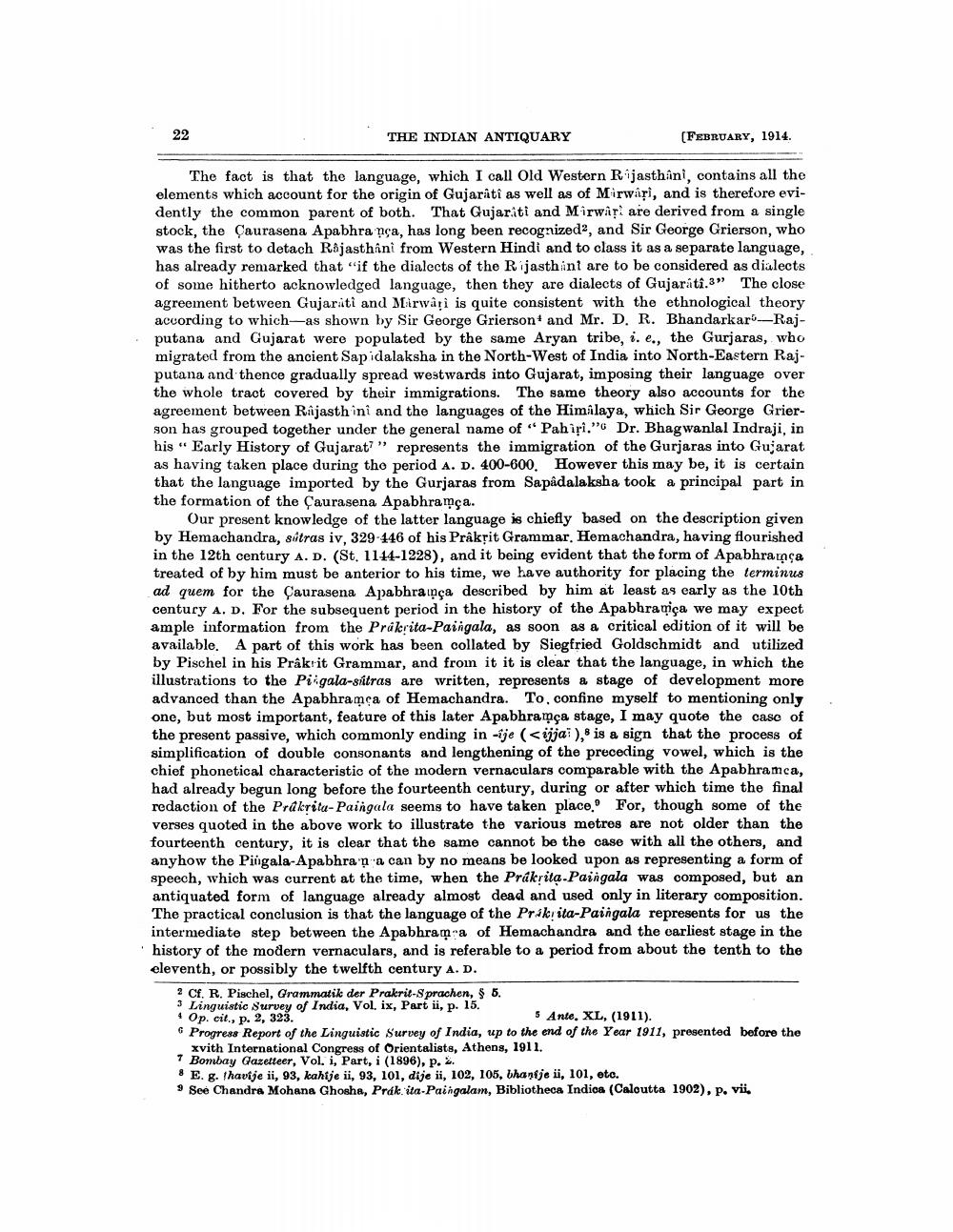________________
22
THE INDIAN ANTIQUARY
(FEBRUARY, 1914.
The fact is that the language, which I call Old Western Rajasthani, contains all the elements which account for the origin of Gujarati as well as of Mirwari, and is therefore evidently the common parent of both. That Gujarati and Mirwari are derived from a single stock, the Çaurasena Apabhra nça, has long been recognized”, and Sir George Grierson, who was the first to detach Rajasthani from Western Hindi and to class it as a separate language, has already remarked that if the dialects of the Rijasthint are to be considered as dialects of some hitherto acknowledged language, then they are dialects of Gujarati.3" The close agreement between Gujariti and Mirwari is quite consistent with the ethnological theory according to which-as shown by Sir George Grierson and Mr. D. R. Bhandarkar'--Rajputana and Gujarat were populated by the same Aryan tribe, i. e., the Gurjaras, who migrated from the ancient Sapidalaksha in the North-West of India into North-Eastern Rajputana and thence gradually spread westwards into Gujarat, imposing their language over the whole tract covered by their immigrations. The same theory also accounts for the agreement between Rajasth ini and the languages of the Himalaya, which Sir George Grierson has grouped together under the general name of " Pahiri." Dr. Bhagwanlal Indraji, in his " Early History of Gujarat?” represents the immigration of the Gurjaras into Gujarat as having taken place during the period A. D. 400-600. However this may be, it is certain that the language imported by the Gurjaras from Sapadalaksha took a principal part in the formation of the Çaurasena Apabhramça.
Our present knowledge of the latter language is chiefly based on the description given by Hemachandra, sitras iv, 329-446 of his Prakrit Grammar. Hemachandra, having flourished in the 12th century A. D. (St. 1114-1228), and it being evident that the form of Apabhramça treated of by him must be anterior to his time, we have authority for placing the terminus ad quem for the Çaurasena Apabhraica described by him at least as early as the 10th century A. D. For the subsequent period in the history of the Apabhramiça we may expect ample information from the Prakrita-Paingala, as soon as a critical edition of it will be available. A part of this work has been collated by Siegfried Goldschmidt and utilized by Pischel in his Prakrit Grammar, and from it it is clear that the language, in which the illustrations to the Pilgala-sitras are written, represents a stage of development more advanced than the Apabhramca of Hemachandra. To, confine myself to mentioning only one, but most important, feature of this later Apabhramça stage, I may quote the case of the present passive, which commonly ending in -ije ( <ijjai), is a sign that the process of simplification of double consonants and lengthening of the preceding vowel, which is the chief phonetical characteristic of the modern vernaculars comparable with the Apabhramca, had already begun long before the fourteenth century, during or after which time the final redaction of the Prakrita-Paingala seems to have taken place. For, though some of the verses quoted in the above work to illustrate the various metres are not older than the fourteenth century, it is clear that the same cannot be the case with all the others, and anyhow the Pingala-Apabhra p'a can by no means be looked upon as representing a form of speech, which was current at the time, when the Prákrita.Paingala was composed, but an antiquated form of language already almost dead and used only in literary composition. The practical conclusion is that the language of the Prikrita-Paingala represents for us the intermediate step between the Apabhrama of Hemachandra and the earliest stage in the history of the modern vernaculars, and is referable to a period from about the tenth to the eleventh, or possibly the twelfth century A. D.
2 Cf. R. Pischel, Grammatik der Prakrit-Sprachen, $ 5. 3 Linguistic Survey of India, Vol. ix, Part ii, p. 15. 4 Op. cit., p. 2, 323.
Ante. XL, (1911). 6 Progress Report of the Linguistic Survey of India, up to the end of the Year 1911, presented before the
ith International Congress of Orientalists, Athens, 1911. 7 Bombay Gazetteer, Vol. i, Part, i (1896), p. 2. * E. g. thavije ii, 93, kahtje ii, 93, 101, dije ii, 102, 105, bhanje ii, 101, etc. 9 See Chandra Mohana Ghosha, Prák, ita-Paingalam, Bibliotheca Indioa (Caloutta 1902), P. vii.




